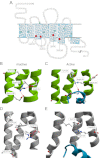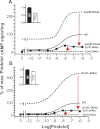The arginine of the DRY motif in transmembrane segment III functions as a balancing micro-switch in the activation of the β2-adrenergic receptor
- PMID: 22843684
- PMCID: PMC3442529
- DOI: 10.1074/jbc.M112.348565
The arginine of the DRY motif in transmembrane segment III functions as a balancing micro-switch in the activation of the β2-adrenergic receptor
Abstract
Recent high resolution x-ray structures of the β2-adrenergic receptor confirmed a close salt-bridge interaction between the suspected micro-switch residue ArgIII:26 (Arg3.50) and the neighboring AspIII:25 (Asp3.49). However, neither the expected "ionic lock" interactions between ArgIII:26 and GluVI:-06 (Glu6.30) in the inactive conformation nor the interaction with TyrV:24 (Tyr5.58) in the active conformation were observed in the x-ray structures. Here we find through molecular dynamics simulations, after removal of the stabilizing T4 lysozyme, that the expected salt bridge between ArgIII:26 and GluVI:-06 does form relatively easily in the inactive receptor conformation. Moreover, mutational analysis of GluVI:-06 in TM-VI and the neighboring AspIII:25 in TM-III demonstrated that these two residues do function as locks for the inactive receptor conformation as we observed increased G(s) signaling, arrestin mobilization, and internalization upon alanine substitutions. Conversely, TyrV:24 appears to play a role in stabilizing the active receptor conformation as loss of function of G(s) signaling, arrestin mobilization, and receptor internalization was observed upon alanine substitution of TyrV:24. The loss of function of the TyrV:24 mutant could partly be rescued by alanine substitution of either AspIII:25 or GluVI:-06 in the double mutants. Surprisingly, removal of the side chain of the ArgIII:26 micro-switch itself had no effect on G(s) signaling and internalization and only reduced arrestin mobilization slightly. It is suggested that ArgIII:26 is equally important for stabilizing the inactive and the active conformation through interaction with key residues in TM-III, -V, and -VI, but that the ArgIII:26 micro-switch residue itself apparently is not essential for the actual G protein activation.
Figures






Similar articles
-
A conserved aromatic lock for the tryptophan rotameric switch in TM-VI of seven-transmembrane receptors.J Biol Chem. 2010 Feb 5;285(6):3973-3985. doi: 10.1074/jbc.M109.064725. Epub 2009 Nov 17. J Biol Chem. 2010. PMID: 19920139 Free PMC article.
-
Biased Gs versus Gq proteins and β-arrestin signaling in the NK1 receptor determined by interactions in the water hydrogen bond network.J Biol Chem. 2015 Oct 2;290(40):24495-508. doi: 10.1074/jbc.M115.641944. Epub 2015 Aug 12. J Biol Chem. 2015. PMID: 26269596 Free PMC article.
-
PheVI:09 (Phe6.44) as a sliding microswitch in seven-transmembrane (7TM) G protein-coupled receptor activation.J Biol Chem. 2012 Dec 21;287(52):43516-26. doi: 10.1074/jbc.M112.395137. Epub 2012 Nov 7. J Biol Chem. 2012. PMID: 23135271 Free PMC article.
-
Ligand binding and micro-switches in 7TM receptor structures.Trends Pharmacol Sci. 2009 May;30(5):249-59. doi: 10.1016/j.tips.2009.02.006. Epub 2009 Apr 16. Trends Pharmacol Sci. 2009. PMID: 19375807 Review.
-
A GPCR that is not "DRY".Mol Pharmacol. 2005 Jul;68(1):1-3. doi: 10.1124/mol.105.014183. Epub 2005 Apr 26. Mol Pharmacol. 2005. PMID: 15855406 Review.
Cited by
-
Temporally Resolved and Interpretable Machine Learning Model of GPCR conformational transition.bioRxiv [Preprint]. 2025 Mar 17:2025.03.17.643765. doi: 10.1101/2025.03.17.643765. bioRxiv. 2025. PMID: 40166135 Free PMC article. Preprint.
-
Luciferase Complementation Approaches to Measure GPCR Signaling Kinetics and Bias.Methods Mol Biol. 2021;2268:249-274. doi: 10.1007/978-1-0716-1221-7_17. Methods Mol Biol. 2021. PMID: 34085274
-
Trace amine associated receptor 1: predicted effects of single nucleotide variants on structure-function in geographically diverse populations.Hum Genomics. 2024 Jun 11;18(1):61. doi: 10.1186/s40246-024-00620-w. Hum Genomics. 2024. PMID: 38863077 Free PMC article.
-
A non-canonical mechanism of GPCR activation.Nat Commun. 2024 Nov 16;15(1):9938. doi: 10.1038/s41467-024-54103-6. Nat Commun. 2024. PMID: 39550377 Free PMC article.
-
Efficient G protein coupling is not required for agonist-mediated internalization and membrane reorganization of the adenosine A3 receptor.FASEB J. 2021 Apr;35(4):e21211. doi: 10.1096/fj.202001729RR. FASEB J. 2021. PMID: 33710641 Free PMC article.
References
-
- Palczewski K., Kumasaka T., Hori T., Behnke C. A., Motoshima H., Fox B. A., Le Trong I., Teller D. C., Okada T., Stenkamp R. E., Yamamoto M., Miyano M. (2000) Crystal structure of rhodopsin: a G protein-coupled receptor. Science 289, 739–745 - PubMed
-
- Rasmussen S. G., Choi H. J., Rosenbaum D. M., Kobilka T. S., Thian F. S., Edwards P. C., Burghammer M., Ratnala V. R., Sanishvili R., Fischetti R. F., Schertler G. F., Weis W. I., Kobilka B. K. (2007) Crystal structure of the human β2 adrenergic G protein-coupled receptor. Nature 450, 383–387 - PubMed
-
- Rasmussen S. G., Choi H. J., Fung J. J., Pardon E., Casarosa P., Chae P. S., Devree B. T., Rosenbaum D. M., Thian F. S., Kobilka T. S., Schnapp A., Konetzki I., Sunahara R. K., Gellman S. H., Pautsch A., Steyaert J., Weis W. I., Kobilka B. K. (2011) Structure of a nanobody-stabilized active state of the β2 adrenoceptor. Nature 469, 175–180 - PMC - PubMed
-
- Rasmussen S. G., DeVree B. T., Zou Y., Kruse A. C., Chung K. Y., Kobilka T. S., Thian F. S., Chae P. S., Pardon E., Calinski D., Mathiesen J. M., Shah S. T., Lyons J. A., Caffrey M., Gellman S. H., Steyaert J., Skiniotis G., Weis W. I., Sunahara R. K., Kobilka B. K. (2011) Crystal structure of the β2 adrenergic receptor-Gs protein complex. Nature 477, 549–555 - PMC - PubMed
Publication types
MeSH terms
Substances
LinkOut - more resources
Full Text Sources

